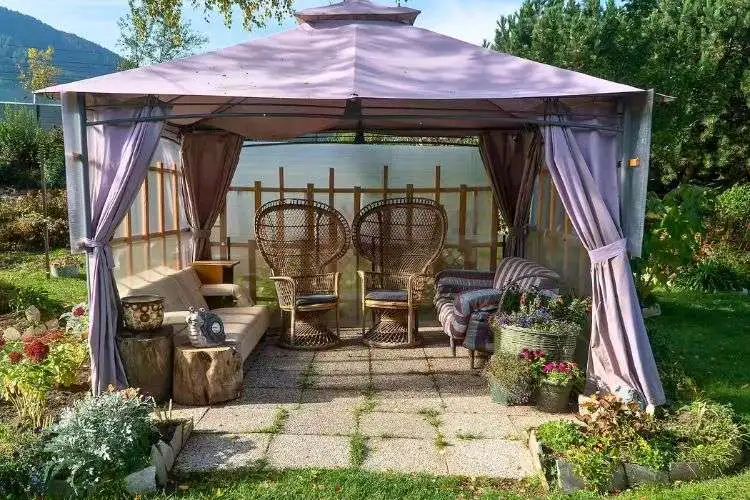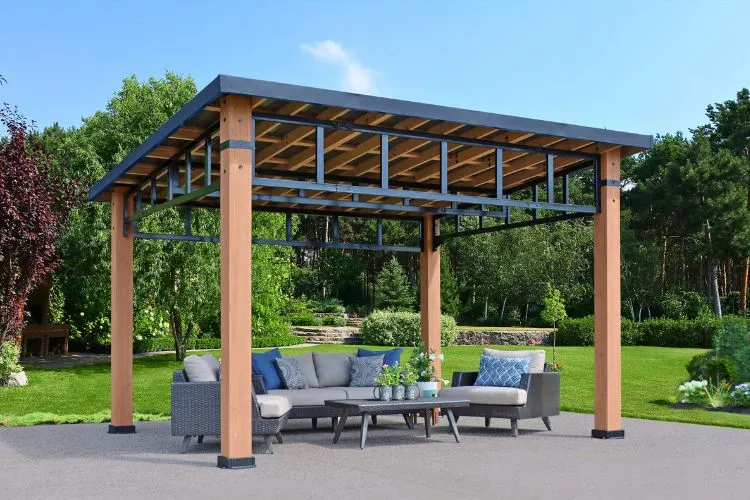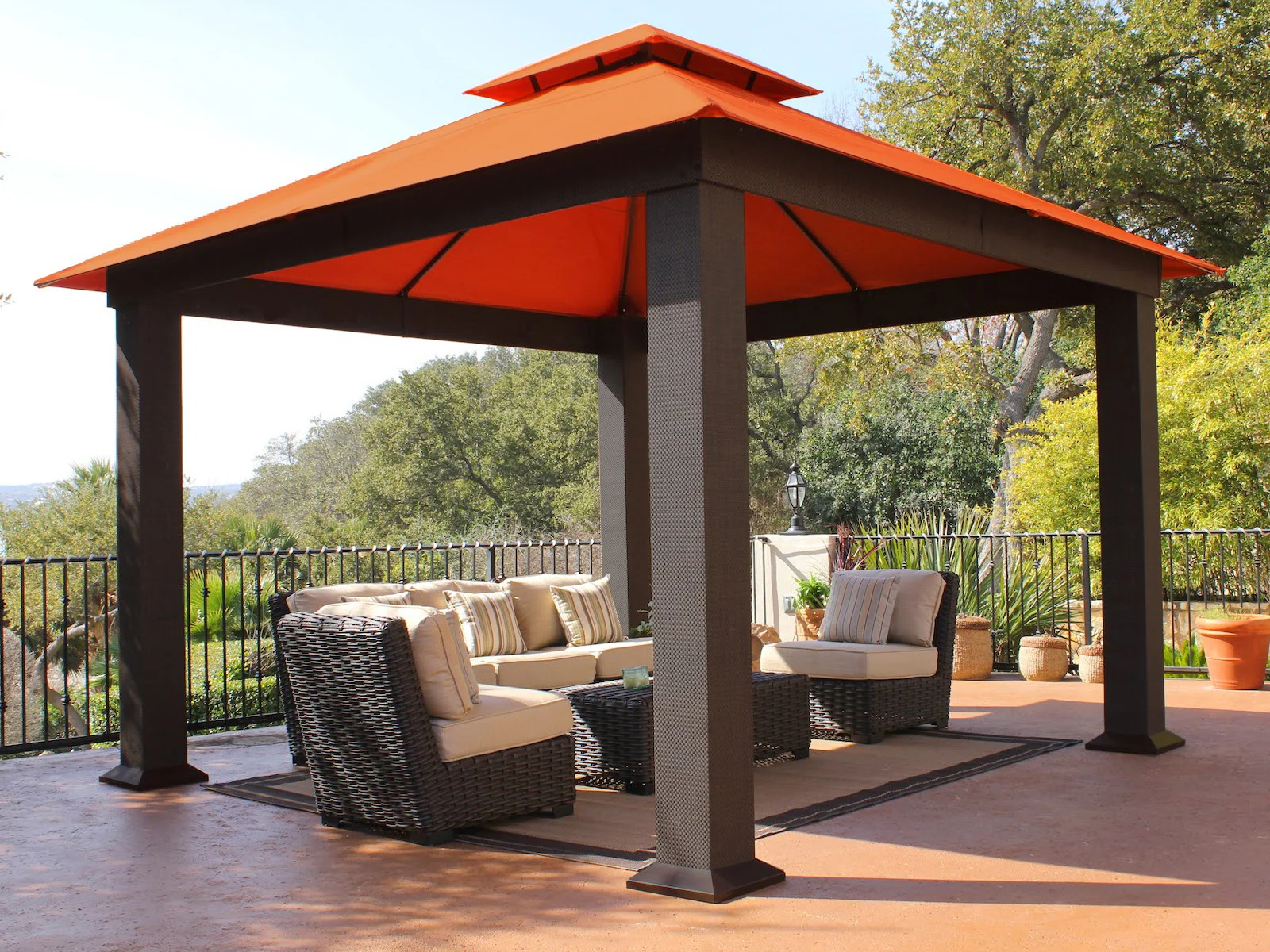Gazebos add elegance and serve as a functional part of outdoor living spaces, providing shade and protection against weather elements.
However, the gazebo cover takes the brunt of weather exposure and might need replacement over time. So, Are Gazebo Covers Interchangeable?
This guide explores the concept of interchangeable covers and provides everything you need to know about selecting the right gazebo cover for durability and aesthetics.

Contents
- 1 Are Gazebo Covers Interchangeable?
- 2 Types of Gazebo Covers Available
- 3 Factors That Determine Interchangeability
- 4 How to Check if a Gazebo Cover is Compatible with Your Frame?
- 5 Tips for Selecting the Right Gazebo Cover
- 6 Care and Maintenance of Gazebo Covers
- 7 Where to Buy Gazebo Covers?
- 8 Common Mistakes to Avoid When Choosing a Gazebo Cover
- 9 The Environmental Impact of Gazebo Cover Materials
- 10 Frequently Asked Questions (FAQs)
Are Gazebo Covers Interchangeable?
Mostly gazebo covers are not interchangeable. Gazebo covers are designed to fit specific models and sizes, making it critical to select a cover that matches the dimensions and design of your gazebo.
Differences in shape, size, and attachment points among gazebos mean that a cover intended for one model may not fit properly on another.
To ensure a correct fit and to avoid issues with installation and coverage, it’s important to use a cover designed for your specific gazebo model.
Types of Gazebo Covers Available
Gazebo covers come in various materials such as canvas, polyester, and polyethylene, each offering different levels of durability and weather resistance.
Covers can also be categorized based on their adaptability and fit—standard, custom, and universal. Standard covers are made to fit specific models and are less likely to be interchangeable.
Custom covers are tailored for a particular frame and design, while universal covers are designed to fit a variety of structures but might not be perfect for every gazebo.
Factors That Determine Interchangeability
The primary factors influencing interchangeability are size, shape, and material of the cover. A mismatch in size and shape can result in a poor fit that fails to protect the structure adequately.
Material compatibility is essential too, as different materials interact with structural elements in various ways. For example, a heavier fabric might put additional stress on a lightweight frame not designed to support it.
How to Check if a Gazebo Cover is Compatible with Your Frame?
To determine if a particular gazebo cover is compatible with your frame, start by measuring your gazebo’s dimensions and shape. Compare these with the cover specifications available on the product description.
Always check the manufacturer’s guidelines for recommended cover types. This step ensures that the cover not only fits but also functions as intended without causing damage over time.

Tips for Selecting the Right Gazebo Cover
When choosing a gazebo cover, consider the climatic conditions to which the gazebo will be exposed. Opt for waterproof and UV-resistant materials if the gazebo is subjected to rain and sun frequently.
The cover’s durability, its ease of maintenance, and its ability to blend with outdoor decor are also important. Price is another factor, but balancing cost with the quality will ensure better longevity and functionality.
Care and Maintenance of Gazebo Covers
Proper care extends the life of gazebo covers. Cleaning the cover regularly to remove debris and mildew is vital.
During the off-season, store the cover in a dry, cool place to prevent damage from rodents and environmental factors. Always repair any tears or damages promptly to prevent them from worsening.
Where to Buy Gazebo Covers?
Purchasing gazebo covers from reputable vendors ensures quality and reliability. Look for suppliers who offer warranties and have good reviews.
Understanding product descriptions and checking compatibility details will help in making an informed decision. It might also be helpful to contact customer service for advice on compatibility issues.
You may also find useful: Can You Dye Gazebo Cover?
Common Mistakes to Avoid When Choosing a Gazebo Cover
When selecting a gazebo cover, it’s essential to be vigilant and informed to prevent costly errors. A frequent mistake is disregarding the material properties; not all fabrics will endure your specific climate conditions. For instance, choosing a canvas cover in an area with heavy snowfall may lead to rapid deterioration.

Another critical oversight is the incorrect assessment of size. A cover too small exposes your gazebo to the elements, while an overly large one can collect water or debris, potentially damaging the structure. This misstep not only affects functionality but also takes away from your gazebo’s aesthetic appeal.
It’s also common to ignore the cover’s attachment mechanisms. Secure fastening systems are crucial in preventing the cover from being lifted or damaged by wind. Ensure the cover integrates well with your gazebo’s design to avoid these issues.
Lastly, overlooking the cover’s maintenance requirements can result in premature wear. Opt for covers that offer a balance of protection and ease of upkeep, ensuring durability without additional labor.
By steering clear of these pitfalls, gazebo owners can enjoy a sturdy and attractive cover that extends the life and beauty of their outdoor sanctuary.
The Environmental Impact of Gazebo Cover Materials
The sustainability of gazebo cover materials is a crucial aspect, with significant environmental implications. Natural fabrics like cotton are biodegradable and have a lower environmental footprint, but they may require more frequent replacement.
Synthetic materials, such as polyester and polyethylene, offer durability and weather resistance but are derived from fossil fuels, contributing to pollution and taking longer to decompose.
Some materials are treated with chemicals for enhanced protection, posing potential risks to wildlife and ecosystems.
Opting for eco-friendly materials, like recycled polyester or organic cotton, can help minimize the environmental impact, promoting a more sustainable option for gazebo covers.
Frequently Asked Questions (FAQs)
Can I use any cover for my gazebo?
Not all covers are universal; compatibility depends on the gazebo’s size, shape, and construction material.
How do I know if a cover is UV-resistant?
Check the product specifications or labels, which typically mention if the material is UV-resistant.
Are heavier covers better for gazebos?
Heavier covers might offer more durability but ensure your gazebo frame can support the extra weight.
How often should I replace my gazebo cover?
Replace your cover when it shows significant wear or damage, typically every few years, depending on material quality and exposure to elements.
Where can I buy gazebo covers?
Reputable outdoor furniture stores or online retailers specializing in gazebo covers offer a variety of options.
Conclusion:
Understanding whether gazebo covers are interchangeable helps in making informed purchasing decisions that align with functionality and design aesthetics.
By considering the factors outlined above, you can select a cover that not only fits your gazebo but also enhances its longevity and usability.
Whether you are replacing an old cover or buying an entirely new gazebo setup, the right knowledge will guide your choice towards the best option available.

Sergio Gomes, a passionate advocate for outdoor living and the male voice behind Shades Authority. With years of experience, Sergio is your trusted source for expert insights on gazebos, pavilions, cabanas, pergolas, and all things outdoor shade solutions. Join him on a journey to transform your outdoor spaces into stunning, functional retreats
